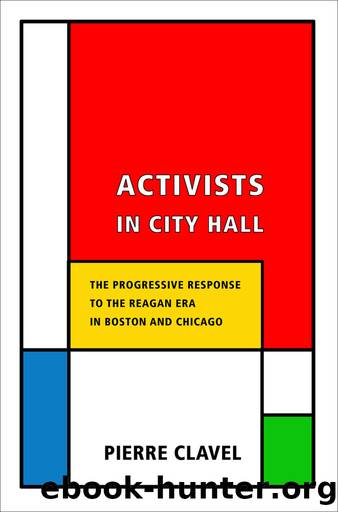Activists in City Hall: The Progressive Response to the Reagan Era in Boston and Chicago by Pierre Clavel

Author:Pierre Clavel [Clavel, Pierre]
Language: eng
Format: epub
Tags: Public Policy, City Planning & Urban Development, United States, Midwest (IA; IL; IN; KS; MI; MN; MO; ND; NE; OH; SD; WI), New England (CT; MA; ME; NH; RI; VT), Political Science, State & Local, History, Politics
ISBN: 9780801460111
Google: AaCdDgAAQBAJ
Goodreads: 9680154
Publisher: Cornell University Press
Published: 2010-10-15T00:00:00+00:00
The Neighborhood Movement
TWO and the North Lawndale CDCs were prototypes, closely tied to the northern arm of the black civil rights movement, originating in protest. There were white organizers and alliesâAlinsky and von Hoffman for TWO, Kreinberg and others in North Lawndale. But black leadership dominated. That the two organizations followed divergent paths in the 1970s and came from divergent class roots was important, but both were different from what came later.
For when neighborhood organizations proliferated in the 1970s and began delivering services in affordable-housing development and economic development, their base had also broadened. Latinos and poor whites formed organizations, and there was a neighborhood movement growing among working-class, typically white populations, especially homeowners. By the later 1970s activists leading a range of groups experiencing displacementâthe loss of âaffordableâ housing units from pressures of various sorts, including the expansion of institutions like universities and hospitalsâconcluded that they themselves needed to get into the housing businessâusually rehabilitation of older structuresârather than limit themselves to protesting or tenant organizing or assuming that either private developers or the city would replace the lost units.
They soon formed networks. One of these activists was Thom Clark, who had been working in the Uptown community. In 1976 he had been meeting with Bob Giloth, then executive director of the Eighteenth Street Development Corporation in Pilsen, a mainly Latino neighborhood. They began meeting on alternate Saturdays, exchanging tips on âwhich foundations were giving us funky groups money, are there any bureaucrats in City Hall who understand what we are trying to do, do you have any contractors who donât rip you off, and where can you find the cheapest toilet in town. In 1977 there was an offer from the city to form a technical assistance center, and they joined with other to form a nonprofit which eventually became the Chicago Rehab Network.â46
Meanwhile, activism increased, partly encouraged by developments in the Carter administration in Washington, where HUD had established an Office of Neighborhoods, but also by the early platform promises of Jane Byrne, who won the mayoralty in 1979 on an antimachine, proneighborhood agenda. When she backed away from this on taking office, neighborhood organizations and various other interests, including independent black political organizations, began to mobilize. There was, by the end of the 1970s, a diverse set of coalitions and organizations servicing the community organizations and pressing the city for political advantage on their behalf. Blacks had organized POWER and ICARE around welfare-rights issues. The Associated Colleges of the Midwest was channeling undergraduates into internship positions, and the University of Illinois at Chicago (UIC) was providing technical assistance through its Center for Urban Economic Development.
By 1982, many of these organizations were mobilizing in protest against the exclusionary and business-favoring policies of the old Daley machine. One coalition was organized to fight a proposed Worldâs Fair, on the basis that it would turn viable neighborhoods south of the Loop into a parking lot. Other organizations had formed to do neighborhood planning in opposition to a downtown business-led effort called the Chicago 21 Plan.
Download
This site does not store any files on its server. We only index and link to content provided by other sites. Please contact the content providers to delete copyright contents if any and email us, we'll remove relevant links or contents immediately.
The Secret History by Donna Tartt(18197)
The Social Justice Warrior Handbook by Lisa De Pasquale(11957)
Thirteen Reasons Why by Jay Asher(8461)
This Is How You Lose Her by Junot Diaz(6452)
Weapons of Math Destruction by Cathy O'Neil(5842)
Zero to One by Peter Thiel(5502)
Beartown by Fredrik Backman(5369)
The Myth of the Strong Leader by Archie Brown(5244)
The Fire Next Time by James Baldwin(5024)
How Democracies Die by Steven Levitsky & Daniel Ziblatt(4966)
Promise Me, Dad by Joe Biden(4912)
Stone's Rules by Roger Stone(4867)
100 Deadly Skills by Clint Emerson(4696)
A Higher Loyalty: Truth, Lies, and Leadership by James Comey(4559)
Rise and Kill First by Ronen Bergman(4549)
Secrecy World by Jake Bernstein(4399)
The David Icke Guide to the Global Conspiracy (and how to end it) by David Icke(4386)
The Farm by Tom Rob Smith(4329)
The Doomsday Machine by Daniel Ellsberg(4250)
